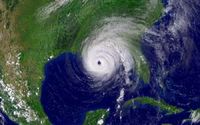NOAA HURRICANE PREPAREDNESS CAMPAIGN GOES AIRBORNE FOR EAST COAST RESIDENTS
> |  |
The team of hurricane experts, aided by local NOAA National Weather Service officials, will ride a WP-3 Orion four-engine turboprop, nicknamed "Miss Piggy," to meet emergency managers, media and the public. Cities on the route: Bangor, Maine; Baltimore, Md.; Richmond, Va.; Charleston, S.C.; and Jacksonville, Fla.
"Every hurricane season, brave men and women board 'hurricane hunter' aircraft from NOAA and the Air Force Reserve to fly into storms and gather data that is critical to producing accurate track and intensity forecasts of the storm," said retired Air Force Brig. Gen. David L. Johnson, director of the NOAA National Weather Service. "I invite the public to meet and greet the best of the best and take to heart their important safety messages."
With this tour, Max Mayfield, director of the NOAA National Hurricane Center says, "Our objective is straightforward: increase awareness of the hurricane threat for a population relatively inexperienced with hurricanes. Most importantly, we want to share lessons learned last year when four hurricanes affected Florida."
 | "The 2004 Atlantic hurricane season was among the most devastating on record," adds Mayfield. "More than 3,100 lives were lost in Haiti, the second largest Atlantic toll in three decades. In the United States, 60 direct deaths were associated with tropical storms and hurricanes." |
"One lesson that bears emphasizing is that loss of life both during and after the hurricane can be prevented with education and a little common sense," Mayfield said.
Dean P. Gulezian, director of the NOAA National Weather Service Eastern Region adds, "Inland flooding and poor human judgment continues to be a lethal combination." Last year, the remnants of the small hurricane, Gaston, dropped more than 12 inches of rain in the Richmond, Va., area causing eight deaths. Five of these were motorists that attempted to drive through flooded roadways.
The NOAA National Hurricane Center will continue its hurricane hazard education campaign during national Hurricane Preparedness Week from May 15-21. Information is now available online.
NOAA, an agency of the U.S. Department of Commerce, is dedicated to enhancing economic security and national safety through the prediction and research of weather and climate-related events and providing environmental stewardship of the nation's coastal and marine resources.
Media Contact:Frank Lepore, NOAA National Hurricane Center, (305) 229-4404, Pager, (800) 759-8888, #1579600; or Marcie Katcher, NOAA National Weather Service Eastern Region, (631) 244-0149











No comments:
Post a Comment